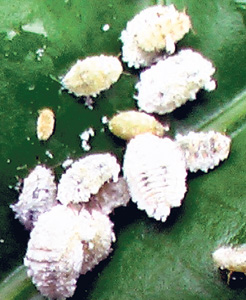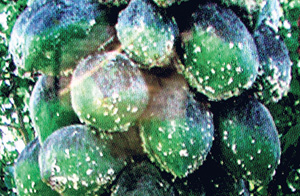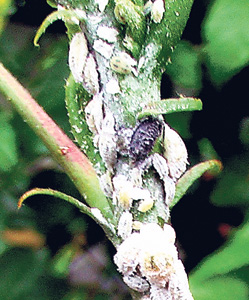The country’s food basket is under attack by an army of tiny foreign bugs that have invaded plants, shrubs and even large trees, leaving behind a trail of devastation.
The culprit, the mealybug, better-known as the piti makuna, started by preying on the beautiful Araliya and humble papaya trees, but has now moved on to almost any tree or shrub that catches its fancy. Jak (kos), breadfruit (del), katuru murunga, mango, amberella, guava, rambutan, ali pera, delum, citrus, ladies’ fingers (bandakka), tomato, chillie, dambala, kankun, melon, manioc and bathala have all become victims of this pest.
“Mealybugs are no strangers to Sri Lanka,” explained K. Piyasena, the Deputy Director of the Gannoruwa-based Plant Protection Unit of the Department of Agriculture, stressing, however, that the kind now attacking the vegetable and fruit cultivations are a new species. Just last week, the unit had got reports that it was attacking rubber trees as well.
This species, Paracoccus marginatus, commonly known as the papaya mealybug prefers papaya as its host plant but is also devouring other plants and tree leaves, The Sunday Times understands.
It was first reported in areas such as Katana and Andiambalama in the Gampaha district, close to the Katunayake airport, says Mr. Piyasena, adding that this pest has now reached epidemic proportions, spreading not only along the coastal areas but also interior.
While Colombo and Gampaha districts have been badly affected, some areas of the Kalutara, Puttalam, Kegalle, Kurunegala and Polonnaruwa districts and also Embilipitiya and some parts of Galle have come under this menace. (See box for harm done by piti makuna).
This particular species was first detected in America in 1955, The Sunday Times understands, moving to the Caribbean in 1994-95 and to South Asia in 2004.
 |
| Officials face a titanic task to elminate the tiny terror. Pic by Kanchana Ariyadasa |
“It is difficult to say from where it came to Sri Lanka but it was reported in Indonesia in 2008, Tamil Nadu in May 2008 and subsequently in June 2008 here,” said Mr. Piyasena.
While many measures are being taken to combat this pest, the million-rupee question is: How did the piti makuna invade this island-nation, with its apparent stringent regulations on the import of bio-material?
The regulations are clear. Anyone who wishes to bring in live plants, fruits, vegetables, flowers, seeds, straw, dried herbs, floral decorations or soil into Sri Lanka needs a permit from the Department of Agriculture. To grant the permit, the department insists that for some of these items an analytical report called the International Seed Testing Assurance (ISTA) certificate needs to be produced, verifying that the items are not diseased or contaminated, The Sunday Times understands.
Along with the shipment must also come a phytosanitary certificate issued by the exporting country, it is learnt, while such shipments are also subjected to screening by the Plant Quarantine Units at entry points such as seaports and the airport.
So how did the piti makuna slip through?
If it came through the proper channels with any agriculture produce it would have been detected, assures Dr. D.H. Muthukuda Arachchi, the Director of the Quarantine Division coming under the Department of Agriculture. However, he points out that the country has an open coast which cannot be controlled for such items entering illegally.
With regard to shipments coming through the proper channels, according to him, if they are not accompanied by the relevant documentation in the form of the mandatory permit and other certification, they would not be released. “They will be burnt and destroyed or sent back to the source country,” he explained.
Other small items like plant sprigs, fruits, flowers and seeds, hand-carried or brought in by travellers in their baggage, without the required permit, would be detected by customs at the airport and referred to the Plant Quarantine Unit, Dr. Muthukuda Arachchi said. “The quarantine officers are trained to check them and release them if there is no problem or send them to the National Plant Quarantine Station at Katunayake for further investigation.”
To further strengthen the screening process, the Quarantine Division is hoping to install a special scanner and is in the process of finding the funding, he said.
Similar views on the stringent checks at the airport are echoed by the Director-General of Customs, C.S.W. Jayatilake. The customs has scanners while spot checks are also carried out, he says. “If we are alerted about certain diseases like in the case of the palathuru messa affecting mangoes in India, we can take further precautions,” he said.
The Customs Department is one of the most active “frontier agencies” and helped prevent diseases such as SARS and avian flu coming into the country, Mr. Jayatilake pointed out, adding, however, that it was very easy to blame the department as well. “No one talks of the major detections made by us.”
Many other quarantine and customs sources, who wish to remain unidentified, pointed out several problems with regard to the coordination between customs and quarantine officials.
“There are system shortfalls,” one source said, explaining that the Plant Quarantine Act had contradictory clauses. Whereas in one instance the regulations specify that customs officials will refer all plant materials to the quarantine officials, in another instance the regulations indicate that quarantine officials have the power to check the baggage of passengers. “But that would depend on the customs officers’ coordination with quarantine officials,” the source said. “Some customs officers are reluctant to allow that as it would enable quarantine officials to see what else was ‘passed’ without being detected. The ultimate harm is to the country.”
It is also important, the source pointed out, to keep track of developments in neighbouring countries and alert the relevant entry points of diseases which could come to Sri Lanka. “That is not happening now.”
Another source emphasized that most plant materials such as flowers, sometimes brought in reed baskets containing 300-400 kilos, grasses and even seeds from India, were passed without any permits or screening due to political interference and customs subservience.
Quoting an incident sometime ago, the source said a huge number of worms could be seen wriggling away from such plant material which had been placed on a big white paper. But nothing was done and it was released.
Yet another source recalled a case where grass seeds along with noxious weeds, even after being spotted, imported by a farm in the hill country got out and were planted.
Reiterating that no instances of political interference had been reported to him by his staff, the Customs Director-General said that no one had asked him personally to carry out such irregularities.
He said that quarantine officers were welcome to be with customs officers when checking passengers. “However it would be impossible to check each and every bag, when a number of flights come in at the same time. If we did and other such departments joined in to carry out additional checks, there would be numerous complaints of delays,” he explained.“The usual practice is for customs officers to direct all suspicious agriculture produce to the quarantine desk,” agreed Quarantine Director Dr. Muthukuda Arachchi.
When asked about the grass and noxious weeds which got into the country, he assured that the whole lot though already planted in the hill country was burnt by his unit.
Meanwhile, on the economic impact of the piti makuna, a source claimed that it had not been assessed yet. But as no reports have come from large-scale cultivations, most probably only home-gardens have suffered the brunt of it.
While the Agriculture Department is waging war against the piti makuna to curb the epidemic before people face starvation due to the poor man’s food being affected, it is also important to ascertain how this pest slipped into the country.
This would help curb such invasions in the future.
How to deal with the bug
The piti maknua is spread by the wind, birds or when infected plant material is transported from one place another while black ants associated with this insect could be a culprit as well, says Plant Protection Unit Deputy Director Piyasena.
 |
| Piti pus is a fungal disease |
On the positive side, however, as it is a soft-bodied insect, it can also be destroyed easily, The Sunday Times learns. The heavy rains experienced in the affected areas have helped reduce the disease.
Here are some of the control measures recommended by Mr. Piyasena:
- Spray water through a high-pressure hose at the affected plant.
- Soap or shampoo mixed with kerosene also helps in controlling the disease.
- Cut the affected leaves and branches. If it is widely spread, prune the tree. Be sure to burn those pruned branches and leaves immediately to prevent the further spread of the disease. Don’t keep such leaves and branches for garbage trucks, as it would aid in the spread of the disease.
- Scrutinise plant material before transportation to ensure non-contamination.
- If large-scale cultivations are affected chemicals such as Imidacloprid (Admire), Thimethoxam (Actara) or Acetamiprid (Fipronil) can be used.
Stressing that public awareness campaigns have been launched, mobilising different target groups, Mr. Piyasena said that the Research and Development Centre of the Agriculture Department is currently planning to airlift a biological control agent, a parasite called Aserophagus papayae, from Puerto Rico to control the spread of the piti makuna.
This parasite lays its eggs on the adult and nymph piti makuna which then feed on the pest, he said. When asked whether this parasite would in turn become a problem in this country, he explained that they would only bring about a balance and not allow the piti makuna to reach harmful levels. “Other countries have tried out this parasite and it has worked.”
Meanwhile, he added that in addition to the piti makuna, rambutan crops had been affected by a fungal disease called piti pus where the fruit gets covered with a downy mildew/mould. “People have mixed up the two as well,” he said. “The piti makuna is a bug while piti pus is caused by a fungus.”
The piti makuna and the ant
The piti makuna belongs to the Insecta class, Hemiptera order and Pseudococcidae family, said Dr. Jayantha Wattavidanage, Senior Lecturer, Department of Zoology, Open University.
It has piercing and sucking mouth parts and though its lifespan is short and its life-cycle usually takes about 21-30 days, warm weather quickens its development and may reduce the cycle by half. Unlike some other insects which have a four-stage life-cycle, the piti makuna has only three: eggs, nymph and adult. The female which is more or less like the nymph has no wings, when compared to the male, and lays about 500-600 eggs, thus spreading rapidly and destroying large extents of crops, he said.
Referring to the harm caused by the piti makuna, Dr. Wattavidanage said its food habit of sucking sap from the plant, causes malnutrition, leading to the death of the plant, while its secretion of toxic proteins poisons the plant. Meanwhile, when it goes from plant to plant it spreads viral diseases.
Dealing with the piti makuna-black ant association, he said while sucking the plant sap, the piti makuna discharges a nutritional sugary solution called honeydew and the ants are attracted by that. “In fact black ants seem to be rearing these bugs to feed on the honeydew,” he said. “So the trees affected by the piti makuna will have hordes of black ants around them.”
Adds Plant Protection Unit Deputy Director Piyasena when it sucks the sap as well and injects the toxic substance, the leaves turn yellow, wither and fall. Tender leaves also become malformed, while flowers and fruits fall off. Honeydew forms a fungus, creating a sooty mould. Fruits and ornamental plants lose their rich colour.
A special feature of the piti makuna is that over its body it forms a protective wax layer, which gives the impression of powder or piti. This is why the affected trees have like a scattering of powder over them, he said.
The shorter life-cycle also means that generations of this insect increase very fast, he added. |



